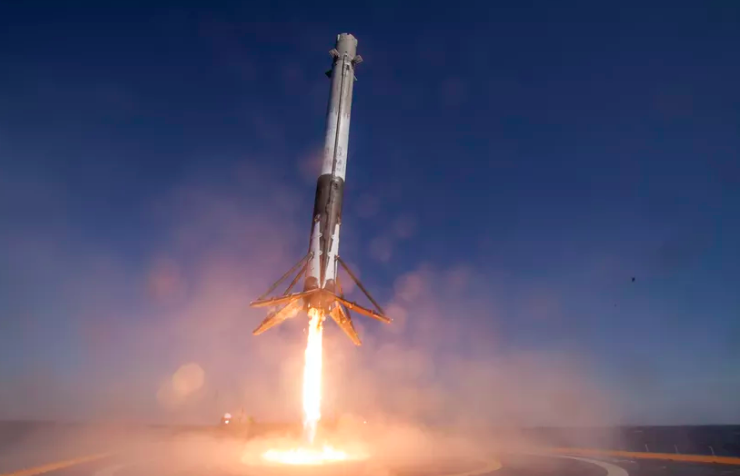
SpaceX today again delayed the launch of its first set of controversial Starlink satellites for 2021. The launch to low-Earth orbit was originally scheduled for January 18, then for today, January 19. Now it’s scheduled for Wednesday, January 20, at 8:02 EST (13:02 UTC; translate UTC to your time) from Launch Complex 39A at the Kennedy Space Center in Florida. The newest set of 60 Starlink satellites will launch on SpaceX’s tried and true Falcon 9 rocket. You can watch the launch live at SpaceX’s website.
This is to be the first of many Starlink launches in 2021, as SpaceX moves toward its goal of placing tens of thousands of these satellites in orbit, with the intention of providing global high-speed broadband internet access.
The Falcon 9’s reuseable first stage previously supported seven other missions.
To allow additional time for pre-launch inspections, now targeting Wednesday, January 20 at 8:02 a.m. EST for launch of Starlink
— SpaceX (@SpaceX) January 19, 2021
https://platform.twitter.com/widgets.js
Due to unfavorable weather conditions in the recovery area, now targeting Tuesday, January 19 at 8:23 a.m. EST for launch of Starlink
— SpaceX (@SpaceX) January 18, 2021
https://platform.twitter.com/widgets.js
Targeting Monday, January 18 at 8:45 a.m. EST for Falcon 9 launch of 60 Starlink satellites from LC-39A; Falcon 9’s first stage previously supported seven missions. Team is keeping an eye on launch and recovery weather ? https://t.co/bJFjLCzWdK
— SpaceX (@SpaceX) January 17, 2021
https://platform.twitter.com/widgets.js

Astronauts in the International Space Station photographed the southern lights and a train of 16 Starlink satellites (each with a unique ID number) on April 13, 2020 over the Southern Ocean off the coast of Antarctica. Image via ISS/ NASA. Also see this video.
Starlink controversy within the astronomy community. Despite the promise of global internet access, both professional and amateur astronomers are fearful that the SpaceX Starlink satellites – which can be glimpsed as “constellations” of moving “stars” – will disrupt observations of the night sky. The National Science Foundation and the American Astronomical Society released a report on the situation in August 2020, following discussions among more than 250 experts at the virtual Satellite Constellations 1 (SATCON1) workshop.
SpaceX recently outfitted some Starlink satellites with a blackened sunshade – called VisorSat – that the company hopes will reduce the satellite’s apparent brightness by reducing the amount of sunlight that’s reflected. That’s just one of six suggestions proposed by the SATCON1 team.
Initial efforts at mitigating the spacecraft’s impact involved launching a prototype Starlink satellite later dubbed DarkSat earlier in 2020, which featured a black antireflective coating. Recent ground-based observations of DarkSat in orbit found it half as bright as a standard Starlink satellite, which is a good improvement, according to experts, but still far from what astronomers say is needed. Jeremy Tregloan-Reed, a University of Antofagasta astronomer on the observational team that assessed the prototype, commented:
I would not consider DarkSat as a victory but instead a good step in the right direction.
The Federal Communications Commission has granted SpaceX permission to launch as many as 12,000 of the flat-panel broadband satellites, but the company has indicated that it intends to send up to 30,000. With those plans – as well as Amazon’s Project Kuiper aiming for 3,236 satellites and OneWeb, a now-bankrupt company recently acquired by the United Kingdom government, perhaps striving for 2,000 – the scale of astronomy’s satellite-constellation problem will only increase.

A time-lapse image shows the passage of a Starlink satellite cluster, creating bright streaks through a telescope’s field of view at the Cerro Tololo Inter-American Observatory of Chile in November 2019. Image via CTIO/ NOIRLab/ NSF/ AURA and DECam DELVE Survey.
Bottom line: SpaceX intends to launch tens of thousands of Starlink satellites, with lifespans of around 5 years, into low-Earth orbit. The goal is global internet access. Astronomers are concerned. Here’s how to watch the launch now scheduled for Wednesday, January 20.
Source:
https://earthsky.org/space/spacexs-1st-starlink-launch-of-2021